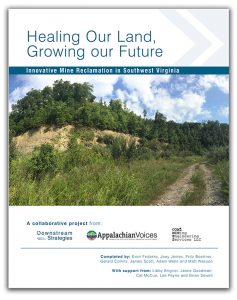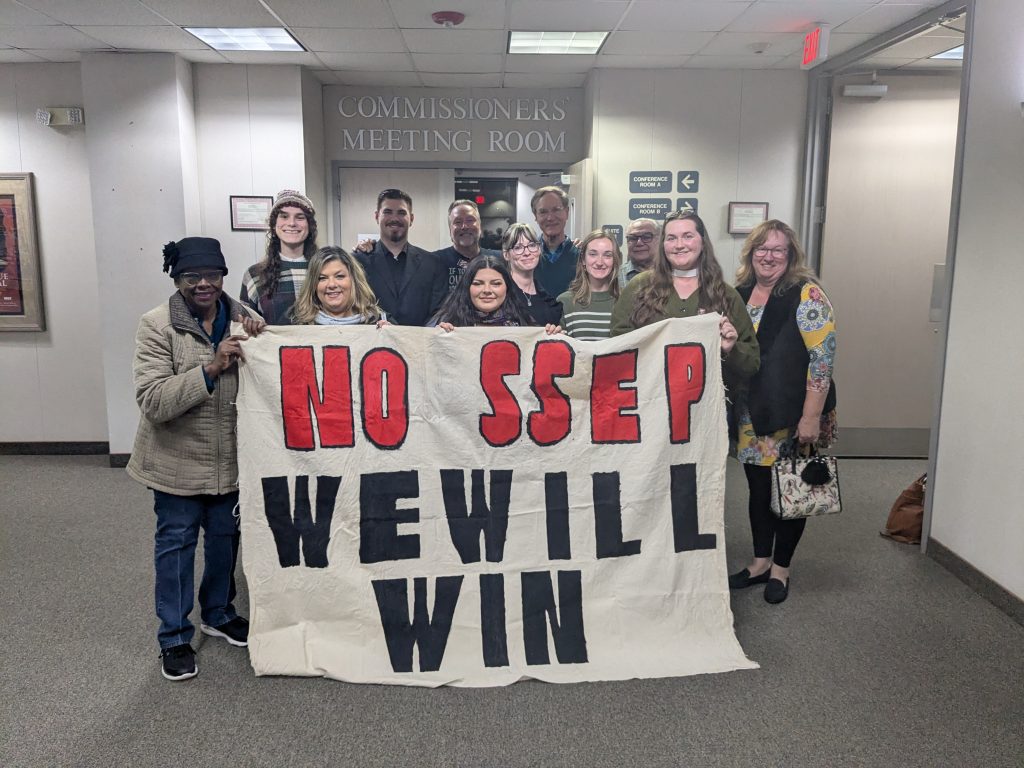Old coal sites ready for new life as greenways, solar farms and more — with federal investment
CONTACT:
Adam Wells, Appalachian Voices, 276-679-1691, adam@appvoices.org
Gerald Collins, Coal Mining Engineering Services LLC, 276-220-0150, gerald1951@comcast.net
Evan Fedorko, Downstream Strategies, 304-292-2450, efedorko@downstreamstrategies.com
WISE COUNTY, VA — A report released today highlights the economic development potential of more than a dozen abandoned coal mining sites in Southwest Virginia that could be repurposed into solar farms, community parks, sustainable farms or other innovative projects with funding from the RECLAIM Act, now pending in Congress.
The report, “Healing Our Land, Growing Our Future,” identifies 14 sites in seven counties that represent the best potential for reclaiming old coal sites and re-developing them with projects that yield lasting and sustainable economic benefits for the surrounding area.
“These sites – and many other abandoned mine lands throughout Appalachia – have been eyesores and health hazards for local communities for over on 40 years,” said Adam Wells, Economic Diversification Program Coordinator with Appalachian Voices, a regional nonprofit organization which published the report. “There’s enormous momentum building at the local level to reclaim these lands for a more sustainable economic future, but we need federal investment to bring that change swiftly.”
Appalachian Voices partnered with Coal Mining Engineering Services LLC and Downstream Strategies to design and implement the analysis of 500 sites in Southwest Virginia officially designated as “abandoned mine lands” (AML) by federal and state regulators. AML sites were closed prior to passage of the 1977 Surface Mining Control and Reclamation Act, which established mining fees to fund reclamation of the old sites.
As the coal industry continues to decline, many Central Appalachian communities are struggling to keep afloat while laying the groundwork for a new, more diversified economy. The RECLAIM Act (“Revitalizing the Economy of Coal Communities by Leveraging Local Activities and Investing More”) would accelerate distribution of $1 billion in existing AML funding over five years for projects that specifically yield economic benefits. Introduced earlier this year, the bill has gained significant bi-partisan support. Virginia would receive a total of $30 million.
“The communities throughout our coalfield counties, from Pennington Gap in Lee County to Pocahontas in Tazewell County, have been devastated by the loss of jobs and revenue from shuttered mines and associated industries,” said Gerald Collins, a native Southwest Virginian and professional engineer who has worked in the coal industry for more than 30 years. “Those communities and their local governments have stood up and with a near unanimous voice, supported the passage of this important legislation, which they hope will help put their residents back to work. It is our hope that this list serves as a ‘to do’ list whenever funding is approved.”
“The opportunity to engage with people and organizations in Southwest Virginia in what can only be described as vital work has been as exciting and rewarding as it is challenging,” said Evan Fedorko, with Downstream Strategies. “The RECLAIM Act and associated monies are a rare opportunity for people to write a new history for the region, and build a prosperous world for themselves, their families, and their neighbors. Downstream Strategies prides itself on using sound science and community planning to pursue bright futures and the ideas and projects profiled here are sterling examples of those principles.”
The research team reached out to a wide variety of local and state stakeholders over the course of the seven-month project for input and feedback. The team established a set of criteria to narrow the list of sites, including size, proximity to infrastructure, proximity to population centers, existing economic development efforts at the site, and land ownership. They also looked for sites suitable for four development sectors: outdoor recreation and eco-tourism, sustainable agriculture and forestry, renewable energy, and conventional commercial/industrial sites. The projects include:
- The Norton Riverwalk, which converts an abandoned coal tipple to a community park at the center of a greenway along the Guest River, in Wise County;
- Lonesome Pine Airport Solar Farm, three adjacent old strip mines where a solar installation could supply clean, renewable energy to nearby companies; and
- Foxfire Farm, a privately-held parcel which includes several old mines. The owner wants to grow her permaculture agriculture business.
Factoring in many unknowns, the team estimated the reclamation costs for all 14 sites between roughly $7.88 million and $16.05 million. The economic development projects totaled roughly between $50.69 million and $52.73 million.
The team also outlined several recommendations at the end of the report: 1) Areas mined after passage of SMCRA should not be automatically excluded from RECLAIM; 2) State and federal AML inventories must be updated with modern mapping technology; 3) Federal funding eligibility guidelines should at a minimum mirror current AML funding guidelines; 4) Coordination of other funding tools to address environmental and safety liabilities for sites not eligible for AML funding and that lack an entity responsible for clean-up; 5) Funding should go toward projects that prioritize local investment versus external corporate interests such as prisons and large retailers; and 6) Reform tax structures to motivate land-holding companies to engage in prioritized projects or sell land to an appropriate entity.
###




